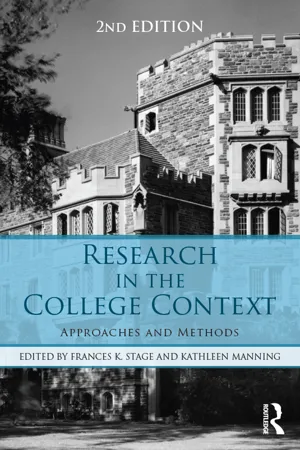
- 228 pages
- English
- ePUB (mobile friendly)
- Available on iOS & Android
About this book
Research in the College Context, 2nd Edition provides faculty, students, practitioners, and researchers in the college environment with a manual of diverse approaches and methods for researching higher education and college students. The text offers the reader a variety of qualitative and quantitative research tools including interviewing, surveys, mixed methods, focus groups, visual methods, participatory action research, policy analysis, document analysis and historical methods, secondary data analysis, and use of large national data sets. This revised edition provides readers with current and innovative methodological tools needed to research the complex issues facing higher education today. Each technique is thoroughly presented with accompanying examples, advice for designing research projects, and tips for data collection, analysis, and dissemination of results. Clearly organized and accessible, this volume is the essential guide for experienced and novice researchers.
Frequently asked questions
- Essential is ideal for learners and professionals who enjoy exploring a wide range of subjects. Access the Essential Library with 800,000+ trusted titles and best-sellers across business, personal growth, and the humanities. Includes unlimited reading time and Standard Read Aloud voice.
- Complete: Perfect for advanced learners and researchers needing full, unrestricted access. Unlock 1.4M+ books across hundreds of subjects, including academic and specialized titles. The Complete Plan also includes advanced features like Premium Read Aloud and Research Assistant.
Please note we cannot support devices running on iOS 13 and Android 7 or earlier. Learn more about using the app.
Information
Table of contents
- Cover
- Half Title
- Title Page
- Copyright Page
- Table of Contents
- Preface
- PART I Developing a Context for Research
- PART II Respondent-Based Methods
- PART III Mixed Methods
- PART IV Using Original and Pre-Existing Data and Resources
- PART V Large Data Set Analysis
- PART VI Communicating your Results—Adding to the Knowledge of the Field
- Contributor Biographies
- Index